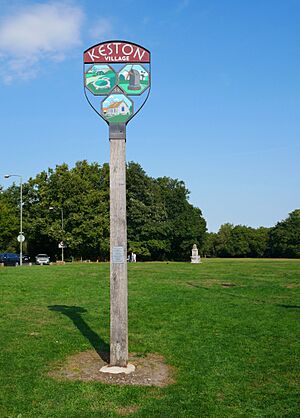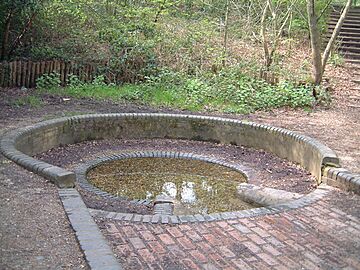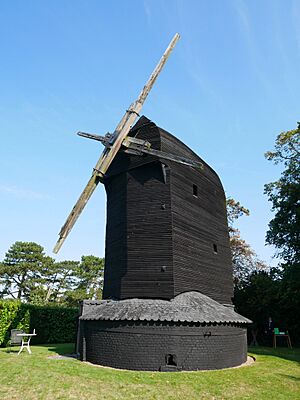Keston facts for kids
Quick facts for kids Keston |
|
|---|---|
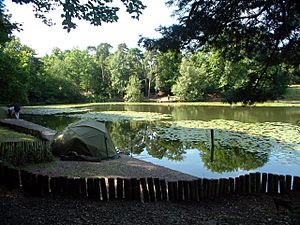 Keston Pond |
|
| OS grid reference | TQ415645 |
| London borough | |
| Ceremonial county | Greater London |
| Region | |
| Country | England |
| Sovereign state | United Kingdom |
| Post town | KESTON |
| Postcode district | BR2 |
| Dialling code | 01689 |
| Police | Metropolitan |
| Fire | London |
| Ambulance | London |
| EU Parliament | London |
| UK Parliament |
|
| London Assembly |
|
Keston is a village in Greater London, England. It is located within the London Borough of Bromley. Before 1965, it was part of the historic county of Kent. Keston is a mix of suburban and rural areas. It sits on the edge of Hayes Common, just outside the main city area of London. A small part of Keston to the southwest is called Nash. The northern, more suburban part of Keston is sometimes known as Keston Mark.
Contents
Keston's Past: A Journey Through Time
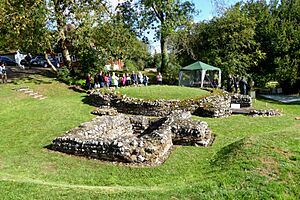
People have lived in the Keston area for a very long time! Tools made of flint and old pit dwellings on Keston and Hayes Commons show that people were here at least 3,000 years before Christ. There are also Iron Age camps in Holwood Park and on Keston Common.
In the valley below the village, you can find the remains of ancient Roman tombs and mausoleums. These date back to the 3rd century AD. They are connected to a nearby Roman villa from the 1st to 4th centuries AD. Archaeologists dug up this villa between 1967 and 1992.
Keston's small medieval church is quite unique. It doesn't have a specific saint it's named after. Instead, its altar has a special cross and the words "The Keston Marke: IN HOC SIGNO VINCES". This means "In this sign, you will conquer."
A famous person who visited Keston often was William Wilberforce. He worked hard to end slavery in the United Kingdom. His close friend, Prime Minister William Pitt the Younger, lived at Holwood Park. It was near an oak tree in Keston that Wilberforce and Pitt talked about stopping the slave trade. Today, only parts of the old "Wilberforce oak" remain. However, a new oak tree has been planted in its place. A stone bench called 'Wilberforce seat' marks the spot. It has a quote from Wilberforce's diary about his decision to fight against the slave trade.
Holwood House was once a simple building. Later, it was rebuilt in a grander style. The Keston Institute, which studies religion and society, was named after Keston. This is because it was located in the old parish school on Keston Common for many years.
There was once a small area called Keston Mark. It was at the edge of Keston village. This area grew a lot in the 20th century. Now, it connects with nearby areas like Locksbottom and Bromley Common.
Keston Park: A Special Community
Keston Park is a gated community. This means it's a private area with its own roads and security. It covers about 140 acres and has around 200 homes. The land for Keston Park was once part of the Holwood Estate.
Many famous people have lived in Keston Park. One of the most well-known was former Prime Minister Margaret Thatcher. She lived there with her husband, Denis, and their children, Mark and Carol. Other famous residents include musician Bill Wyman from The Rolling Stones, footballer Kenny Sansom, and some popular YouTube stars like KSI and Miniminter.
Keston Park's Beginnings
Keston Park began when Frederick Rogers bought 143 acres of land in 1923. He paid £6,000 to the Earl of Derby to develop this special community.
The land was known as the Keston Lodge Estate. Keston Lodge was a large house connected to Holwood House. It later became the Keston Park Hotel but was taken down in the 1960s. Now, houses stand where it once was.
You can still see some parts of the old Keston Lodge Estate today. There are three fishponds on Keston Common, near Fishponds Road. These ponds were built in the early 1800s to supply water to Holwood House. Now, they are a popular place for people to relax and enjoy nature.
River Ravensbourne: Keston's Own River
The River Ravensbourne starts at a place called Caesar's Well near Keston Ponds. This river is about 11 miles long. It flows through the London Boroughs of Bromley, Lewisham, and Greenwich. A group called Quaggy Waterways Action Group (QWAG) has worked hard since 1991 to keep the River Ravensbourne healthy.
The "London LOOP" walk, a long walking path around London, passes by the ponds. Every year on May 1st, very early in the morning, the Ravensbourne Morris Men dance at Caesar's Well. This is a special tradition to welcome the sunrise.
Local Gathering Spots: Keston's Pubs
Keston has three pubs, which are traditional English places to eat and drink. The Two Doves is on Oakley Road. The other two are in the village itself: The Fox Inn and the Greyhound.

The Greyhound pub is famous locally for a special event. Every Boxing Day, the Ravensbourne Morris Men perform their traditional Morris dances there. They have been doing this since 1963 and collect money for charity.
Keston's Windmills: A Glimpse into the Past
Keston has had three windmills over the years. One is the post mill built in 1716. It still stands on Keston Common today. Another was a smock mill called Olive's Mill, built in 1824. It sadly burned down later. A third windmill was located at Holwood Park.
St. Audrey's: A Church with a History
A small private church dedicated to St. Audrey was built in 1889. It was on the site of Olive's Mill. This church and other mill buildings became part of the local parish in 1908. For many years, the old Olive's Mill House was used as the rectory (the home of the church's priest). The mill buildings were used as church rooms for almost a century. The church building is now used for other purposes.
Getting Around: Transport in Keston
Trains
The closest train station to Keston is Hayes. It's about 1.5 miles away to the northwest.
Buses
Keston is part of Greater London and the Transport for London area. Several London Buses routes serve Keston. Two bus routes stop right in the village. Four other routes stop within a ten-minute walk at Keston Mark. These buses connect Keston to places like Bromley North, Biggin Hill, and Orpington.
- 146 – Downe to Bromley North via Keston and Old Hayes
- 246 – Westerham to Bromley North via Biggin Hill, Keston, Coney Hall and Hayes
- 320 – Biggin Hill Valley to Catford Bridge via Keston Mark, Bromley and Downham
- 664 (school journeys) – New Addington to Biggin Hill (Charles Darwin School)
- 684 (school journeys) – Orpington Station to Biggin Hill (Charles Darwin School)
- R2 – Biggin Hill Valley to Orpington via Keston Mark and Locksbottom
Images for kids




